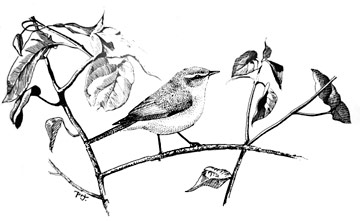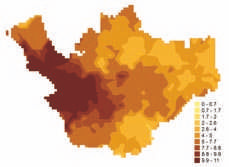
Chiffchaff © Phil Jones
In the last twenty years, Chiffchaffs have flourished and fieldwork for this Atlas has confirmed that it is now our most ubiquitous warbler and our second most widespread summer migrant: they now occur in 615 tetrads, a net gain of 166 since our First Atlas. They are missing only from the treeless areas of the eastern hills and the estuarine fringes, along with the most urban parts of towns such as Birkenhead, Widnes, Northwich and Crewe. The abundance map shows their highest densities in west Cheshire and Wirral. The BTO analysis of Cheshire and Wirral BBS gives a county breeding season population in 2005 of 15,800 (11,630-19,970) Chiffchaffs, an average of 25 birds per tetrad in which they were recorded. The authors of the First Atlas suggested a county population, just twenty years previously, of perhaps 1,500 pairs.
Male Chiffchaffs are usually the first summer migrant to reappear in Cheshire and Wirral woods, and they probably spend the longest period in Britain of any migrant species. One ringed individual at Woolston in 1990 was well-studied from its arrival on 18 March to its final capture on 26 September, having spent over half of the year at the site. Arrivals by mid-March are usual in most years, with birds instantly recognised by their song, not quite as boring as at first it seems, most birds breaking up their monotonic ‘chiff-chaff’ with trisyllabic variations and the ‘trr’ interludes, perhaps increasingly so as the season goes on. When the females arrive, two or three weeks later, they pair rapidly and she quickly builds and occupies a nest. Their typical clutch size is 5 or 6 eggs, rather than the Willow Warbler’s 7, probably because of the increased load on the female. A male Chiffchaff plays little part in anything to do with the nest; he does not feed the female, and does not feed the chicks. His role appears to be to establish and defend the territory, and he stands guard, singing and giving the alarm when necessary, throughout the breeding period.

Chiffchaff abundance.
The Chiffchaff is mostly a bird of woodland, but, as the population has increased, they have spilled out into farmland and other areas. The first birds back each year fill up the preferred deciduous woods, and later-arriving birds – thought to be the one-year-old birds breeding for the first time – occupy poorer quality woods, hedges and elsewhere (Clement 1995). With Cheshire and Wirral being a relatively sparsely-wooded county, it is perhaps surprising that such a high proportion of our Chiffchaffs are in woodland: habitat codes reported in this survey were 61% woodland, 19% scrub, 9% farmland and 10% human sites.
In the twenty years between our Atlas periods (1984-2004) the national population index for Chiffchaff has risen by 180%. Lack of management has accelerated the habitat progression from scrub towards the Chiffchaffs’ favoured more-mature woodland; many well-recorded sites have seen a substantial shift in the relative proportions of these two common Phylloscopus warblers. Further, the consequent decline of the Willow Warbler has allowed some Chiffchaffs to spread into less-wooded habitats. Finally, their migratory strategy might have benefited this species. In winter, British breeding birds go south to the Mediterranean, with some crossing the Sahara to the region from Mauritania to Guinea-Bissau. Short-distance migrants – such as many Chiffchaffs – tend to have prospered at the expense of those undertaking longer journeys, perhaps because they are better able to adjust their seasons to climate change.
Sponsored by D. and K. Leeming

